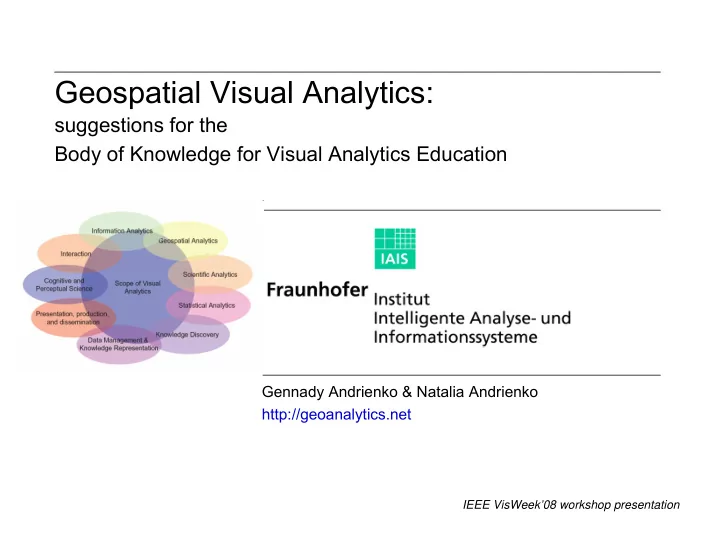

Geospatial Visual Analytics: suggestions for the Body of Knowledge for Visual Analytics Education Gennady Andrienko & Natalia Andrienko http://geoanalytics.net IEEE VisWeek’08 workshop presentation
Outline What is special about spatial data � Outline of the body of knowledge on geospatial VA � Existing assets � Gennady & Natalia Andrienko 2 http://geoanalytics.net/and
What is special about spatial data ? Spatial heterogeneity characteristics of spatial data � • continuous (measurements are not → error) - places are different (urban vs. rural areas, • error in: sea vs. land…) > locations (projection, etc.) > distances (elevation; constraints; alternatives) - spatial processes operate differently in > attributes (poor models; limited samples) different places > time • complexities: - spatial relationships may differ according to > scale (features / processes scale dependent) direction… > time-dependence Autocorrelation in space and time � … of temporal data - Tobler’s law: Everything is related to • time is linear AND • time is cyclical everything else, but near things are more • multiple embedded & related than distant things overlapping cycles Scale � Need to integrate human’s sense of space and - Patterns differ depending place, tacit knowledge about their properties on scale and relationships Gennady & Natalia Andrienko 3 http://geoanalytics.net/and
Dimensionality of data in Geospatial Visual Analytics multi-dimensional data + geographical space and time that require special attention: � - Space includes 2 or 3 coordinates plus the geographical context (which is difficult to formalize) - Time has two models, linear and cyclical; often necessary to consider simultaneously several temporal cycles (monthly, weekly, daily etc.; these cycles may overlap) Gennady & Natalia Andrienko 4 http://geoanalytics.net/and
Complexity of data in Geospatial Visual Analytics Example: data about moving entities � Multiple different data sets need to be analyzed together: � - moving entities and their properties; - spatial positions with time stamps and other characteristics (speed, direction…); - relevant objects in geo-space (buildings, roads…); - relevant events and processes in time (football game, earthquake, IEEE VisWeek, global warming, US elections…) Interplay of geography, time and entities: � - e.g. a {dynamic} query should operate characteristics of movement such as speed, acceleration, direction, turn; all in geographical and temporal context Gennady & Natalia Andrienko 5 http://geoanalytics.net/and
Summary In geospatial visual analytics it is necessary to work simultaneously with multiple data sets of different structure � using several visual representations and computational methods working together � General notes: geography is not just x,y{,z}; � a map is not equivalent to a scatter plot: � - a map usually contains several information layers (spatial context) - and can activate analyst’s knowledge about space & places distances in geo space ≠ distances on a plane � - distances on the Earth surface - domain-specific distances, e.g. along roads; anisotropy - barriers, inaccessible places, … Gennady & Natalia Andrienko 6 http://geoanalytics.net/and
Outline of the Body of Knowledge on Geospatial VA Spatial and spatio-temporal objects and phenomena: types and properties � Representation of phenomena and objects in data; types of spatial and spatio- � temporal data Visualisation of spatial information: cartographic principles and representation � techniques; geovisualisation Transformations of spatial and spatio-temporal data � Elements of spatial statistics � Analytical methods for different types of spatial and spatio-temporal data � Spatial decision support � Gennady & Natalia Andrienko 7 http://geoanalytics.net/and
Elements of Body of Knowledge Types of Spatial Objects and Phenomena Discrete spatial objects vs. spatially continuous phenomena � Point, lines, areas, surfaces � Smooth vs. abrupt spatial variation � Spatial divisions and spatially aggregated information � … � Role of scale � Gennady & Natalia Andrienko 8 http://geoanalytics.net/and
Elements of Body of Knowledge Types of Temporal Variance Changes of thematic properties (values of attributes) associated with places � - e.g. district population, data from stationary sensors Existential changes (appearance and disappearance) � Events: objects with limited life time - e.g. earthquakes, traffic incidents, observations of rare plants or animals Changes of spatial properties: location, size, shape, orientation, altitude, etc. � - e.g. movement of vehicles, growth of cities … � Gennady & Natalia Andrienko 9 http://geoanalytics.net/and
Elements of Body of Knowledge Visual representation and interaction (an example) click here to move the transform the slider colour scale and from sequential observe to diverging how the map changes Gennady & Natalia Andrienko 10 http://geoanalytics.net/and
Elements of Body of Knowledge Visual representation and interaction (patterns to look for) By moving the slider, we see more patterns and gain more understanding of value distribution Porto Lisboa Clusters of One more Clusters of Coast-inland West-to- low values high values in cluster of contrast east around low values central-east increase Gennady & Natalia Andrienko 11 Porto and http://geoanalytics.net/and Lisboa
Spatial decision support Specific features of spatial decision support problems: Complex nature of geographic space � Multiple actors with different roles � Tacit criteria and knowledge � Requirements to Visual Analytics: Support decision making as a process (stages: intelligence, design and choice) � Support exploration of the problem and solution options � Support rational choice � Support reasoning, deliberation and communication � Support time-critical decision making � Support analysis of decision effectiveness and revision of decisions � Support different actors � Gennady & Natalia Andrienko 12 http://geoanalytics.net/and
Course on Geospatial Visual Analytics http://geoanalytics.net/and/lecturesVA Gennady & Natalia Andrienko 13 http://geoanalytics.net/and
http://geoanalytics.net welcome to join our activities! GIScience 2006 workshop outcomes: � Special issue on “GeoVisual Analytics for Spatial Decision Support”, including “Setting the Research Agenda” paper Int.J.GIScience , 2007, v.21(8) AGILE 2008 workshop (May 2008, Girona, Spain) � “GeoVisualization of Dynamics, Movement and Change” Special issue of Information Visualization (issue 3/4, 2008), including “Key issues & developing approaches” paper http://geoanalytics.net/GeoVis08/ (long abstracts, slides) GIScience workshop (September 2008, Salt Lake City, USA) � “Geospatial Visual Analytics” forthcoming special issue of Cartography and GIScience (issue 3, 2009) http://geoanalytics.net/GeoVisualAnalytics08/ (long abstracts, slides) Gennady & Natalia Andrienko 14 http://geoanalytics.net/and
Recommend
More recommend